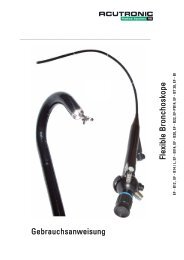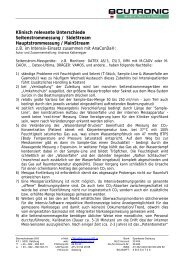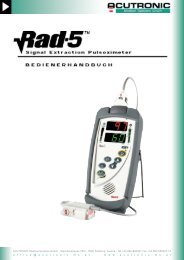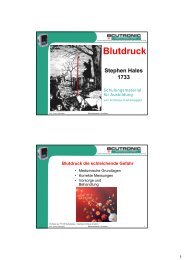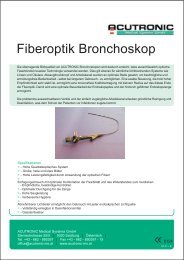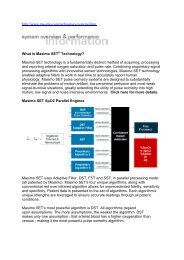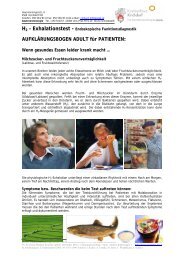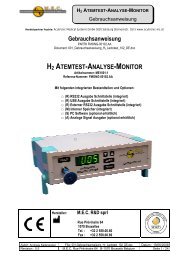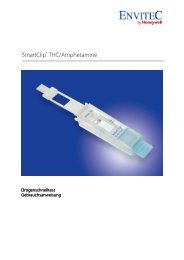Summary Carbon Monoxide Lurking within: The Danger of ...
Summary Carbon Monoxide Lurking within: The Danger of ...
Summary Carbon Monoxide Lurking within: The Danger of ...
Create successful ePaper yourself
Turn your PDF publications into a flip-book with our unique Google optimized e-Paper software.
m a s i m o c o r p o r a t i o n 4 0 p a r k e r i r v i n e c a 9 2 6 1 8 w w w. m a s i m o . c o m<br />
Carboxyhemoglobinemia in Acute Care<br />
V. Detection Systems: Expired CO, CO-Oximetry and Pulse CO-Oximetry<br />
Two methods have been widely studied for assessing CO concentrations in clinical practice:<br />
exhaled CO and COHb levels measured via CO-Oximetry. <strong>The</strong> differences between the readings<br />
obtained from the two methods have deemed exhaled CO to be clinically acceptable for the<br />
purposes <strong>of</strong> epidemiological studies, but only in those few patients who can perform a robust,<br />
repeatable vital capacity maneuver and in those patients without cardiopulmonary compromise.<br />
While the end-expired method can be used to measure moderate and low COHb levels in<br />
individuals, patients admitted with CO poisoning or who are otherwise critically ill are not in<br />
a state to blow a sample <strong>of</strong> expired air into an analyzer sample reservoir. <strong>The</strong>refore, taking a<br />
sample <strong>of</strong> blood is the primary method by which COHb level is measured in cases with high acuity.<br />
In hospitals, the most common means <strong>of</strong> measuring CO exposure is a CO-Oximeter. A blood<br />
sample, under a physician order, is drawn from either venous or arterial vessel and injected<br />
into a laboratory CO-Oximeter. <strong>The</strong> laboratory device measures the invasive blood sample<br />
using a method called spectrophotometric blood gas analysis. 67 Because the CO-Oximeter can<br />
only yield a single, discrete reading for each aliquot <strong>of</strong> blood sampled, the reported value is<br />
a noncontinuous snapshot <strong>of</strong> the patient’s condition at the particular moment that the sample<br />
was collected. Another issue that pr<strong>of</strong>oundly affects the clinical usefulness <strong>of</strong> invasive CO-<br />
Oximetry relates to the relative paucity <strong>of</strong> devices currently purchased by and installed in acute<br />
care hospitals. One recent study indicates that fewer than half <strong>of</strong> hospitals in the U.S. have the<br />
necessary equipment on site to diagnose CO poisoning. 68 For those that did not have the testing<br />
equipment, the average time to receive results <strong>of</strong> a blood sample sent to another facility was<br />
over 15 hours.<br />
Conventional two-wavelength pulse oximeters are incapable <strong>of</strong> isolating the carbon monoxide<br />
contaminated hemoglobin from oxyhemoglobin. 69 Of greater potential confusion and negative<br />
consequence, two-wavelength oximeters will report carboxyhemoglobin as oxygenated<br />
hemoglobin, a false negative with potentially fatal results.<br />
<strong>The</strong> latest technology in CO poisoning detection in the acute care setting is Masimo Rainbow<br />
SET Pulse CO-Oximetry [Masimo Corporation, Irvine, CA]. This is the first technology that allows<br />
clinicians to non-invasively detect and continuously monitor CO levels in the bloodstream. Using<br />
one sensor with more than 7 wavelengths <strong>of</strong> light to distinguish the various forms <strong>of</strong> hemoglobin<br />
(oxy-, deoxy-, carboxy- and met-) the device is capable <strong>of</strong> measuring blood SpCO levels, in<br />
addition to pulse rate, arterial hemoglobin oxygen saturation during motion and low perfusion,<br />
perfusion index, plethysmograph variation index (PVI) and SpMet. <strong>The</strong> device’s accuracy has<br />
been demonstrated to 40 percent SpCO, with a range <strong>of</strong> ±3 percent (at 1 Standard Deviation)<br />
around the measurement. 70 <strong>The</strong> trending feature benefit <strong>of</strong> the Rainbow technology platform<br />
allows for the real-time monitoring <strong>of</strong> the critical dyshemoglobins COHb and MetHb, permitting<br />
prophylactic and/or early interventions to elevations <strong>of</strong> the critical dyshemoglobins. Since these<br />
dyshemoglobins can change their pr<strong>of</strong>ile and effect dynamically during the course <strong>of</strong> therapy,<br />
trend monitoring through continuous evaluations is considered a significant breakthrough.<br />
Non-invasive monitoring reduces the opportunity for hospital acquired infection, sepsis and<br />
overall patient discomfort. Needle-free testing means a safer environment for patients and<br />
caregivers alike. In addition, the immediacy <strong>of</strong> results available at the point <strong>of</strong> care represents<br />
a less resource intensive, streamlined workflow. As opposed to conventional CO-Oximetry<br />
which requires a new blood sample for each time a status <strong>of</strong> dyshemoglobins is required, the<br />
continuous nature <strong>of</strong> the Masimo Rainbow SET Pulse CO-Oximeter platform enables the ability<br />
to non-invasively trend data over time.



